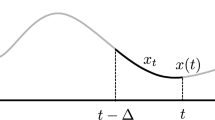Abstract
A new approach to the study of delay systems, applicable to physiological control systems and other systems where little information about the time delays is available, is examined. The method is based on the fact that stability information can be deduced from the statistical properties of the probability distribution that encodes the structure of the time delay. The main statistical variables used are the usual expectation parameter,E, and a modified variance, calledrelative variance and denotedR, that is invariant under time scale changes. Recent work of the author has shown that stability often improves asR increases whileE remains fixed. A four-parameter family of delay models is analysed in this paper, and the (E, R) pair is found to be a reliable indicator of stability over the global parameter domain of the family.
Similar content being viewed by others
References
Anderson, R. F. V. (1991). Geometric and probabilistic stability criteria for delay systems.Math. Biosci. 105, 81–96.
Anderson, R. F. V. (1992). Intrinsic parameters and stability of differential-delay equations.J. Math. Anal. Appl. 163, 184–199.
Ansoff, H. I., and Krumhansl, J. A. (1948). A general stability criterion for linear oscillating systems with constant time lag.Q. Appl. Math. 6, 337–341.
Bellman, R., and Cooke, K. L. (1963).Differential-Difference Equations, Academic Press, New York.
Cooke, K. L., and Grossman, Z. (1982). Discrete delay distributed delay and stability switches.J. Math. Anal. Appl. 86, 592–627.
Cushing, J. M. (1977).Integrodifferential Equations and Delay Models in Population Dynamics, Lecture Notes in Biomathematics, Vol. 20, Springer-Verlag, New York.
Gantmacher, F. R. (1959).The Theory of Matrices, Vol. II, Chelsea, New York.
Glass, L., and Mackey, M. C. (1988).From Clocks to Chaos, Princeton University Press, Princeton, N.J.
Hartree, D. R., Porter, A., Callender, A., and Stevenson, A. B. (1937). Time Lag in a Control System (II).Proc. Roy. Soc. A 161, 460–476.
Kalecki, M. (1935). A macrodynamic theory of business cycles.Econometrica 3, 327–344.
MacDonald, N. (1978).Time Lags in Biological Models, Lecture Notes in Biomathematics, Vol. 27, Springer-Verlag, New York.
MacDonald, N. (1989).Biological Delay Systems: Linear Stability Theory, Cambridge Studies in Mathematical Biology, Vol. 8, Cambridge University Press, Cambridge.
Mackey, M. C., and Glass, L. (1977). Oscillation and chaos in physiological control systems.Science 197, 287–289.
Milton, J. G., Longtin, A., Beuter, A., Mackey, M. C., and Glass, L. (1989). Complex dynamics and bifurcations in neurology.J. Ther. Biol. 138, 129–147.
Minorsky, N. (1942). Self-excited oscillations in dynamical systems possessing retarded actions.J. Appl. Mech. 9, 65–71.
Sharpe, F. R., and Lotka, A. J. (1923). Contribution to the analysis of malaria epidemiology. IV. Incubation lag.Suppl. Am. J. Hygiene 3, 96–112.
Walther, H.-O. (1976). On a transcendental equation in the stability analysis of a population growth model.J. Math. Biol. 3, 187–195.
Author information
Authors and Affiliations
Rights and permissions
About this article
Cite this article
Anderson, R.F.V. The relative variance criterion for stability of delay systems. J Dyn Diff Equat 5, 105–128 (1993). https://doi.org/10.1007/BF01063737
Received:
Revised:
Issue Date:
DOI: https://doi.org/10.1007/BF01063737



